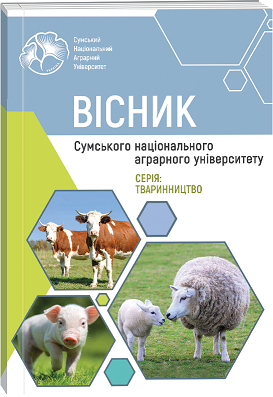REPRODUCTIVE QUALITIES OF SOWS OF MATERNAL AND PATERNAL LINES IN THE CONDITIONS OF A BREEDING BREEDER
Abstract
The aim of the article was to investigate the dependence of reproductive productivity of sows for breeding on maternal and paternal genotypes. To study the reproductive qualities of sows of maternal and paternal genotypes, the analysis of productivity of sows of maternal (large white and landrace) and paternal (synthetic line Maxgro) Irish selection was carried out in terms of the total number of piglets born, sows of large white breed probably outnumbered their analogues from the experimental groups by 1.29 (p <0.01) and 6.23 (p <0.001) heads, which indicates the great potential for multifertility of this maternal line. Sows of other maternal breeds also predominated by 4.94 (p <0.001) heads of their peers of the paternal synthetic line. In our studies in sows of maternal genotypes, due to their high fertility, the survival of piglets before weaning on the 28th day of their life was 22.85 and 17.70% (p <0.001) worse compared to animals of the paternal synthetic line. The worst survival was found in sows of the control group, which on this indicator were inferior to 4.85% of their peers of the Landrace breed (p <0.05). In terms of nest weight of piglets at weaning, Landrace sows outperformed their large white breed counterparts by 7.12 kg (p <0.01) and 4.24 kg (p <0.05) by their peers of the parental Maxgro synthetic line. In turn, no significant differences were found in the nest weight of piglets when weaned from sows of large white breed and synthetic line Maxgro. According to the complex of reproductive traits, which were determined by calculating the selection index of reproductive qualities of sows (SIVYAS), the best were sows of large white breed 97.72 points. Animals of another maternal line in the Landrace breed were only 0.84 points behind them. At the same time, sows of both maternal genotypes were superior to the analogues from the paternal synthetic line Maxgro by 31.64 and 29.66 points.
References
2. Михалко О. Г. Сучасний стан та шляхи розвитку свинарства в світі та Україні. Вісник Сумського національного аграрного університету. Серія "Тваринництво", 2021, Вип. 3, С. 60–77.
3. Михалко О. Г., Повод М. Г., Андрійчук В. Ф., Вплив методів розведення та віку свиноматок данської селекції на їх продуктивність. «НТБ ІТ НААН», 2021, №125, С. 161–179.
4. Никитченко И.Н., Никитенко Р. Н., Горин В. В. Программа гибридизации в свиноводстве Белоруссии на основе селекционно-гибридных центров. Повышение эффективности свиноводства. М. Агроиздат, 1991, С. 19–28.
5. Оглобля В. В., Повод М. Г. Відтворювальні якості свиноматок ірландського походження за чистопородного розведення та схрещування в умовах промислового комплексу. Вісник Сумського національного аграрного університету. Серія "Тваринництво", 2020, Вип. 1(40), С. 103–107.
6. Церенюк О. М. Гетерозис у свинарстві. Сучасне тваринництво. [Електроний ресурс]. – Режим доступу: http://agro-business.com.ua/agro/suchasne-tvarynnytstvo/item/8035-heterozys-u-svynarstvi.html (дата звернення 30.09.2021)
7. Церенюк О. М., Хватов А. І., Стрижак Т. А. Оцінка ефективності індексів материнської продуктивності свиней. Сучасні проблеми селекції, розведення та гігієни тварин. Зб. наук. праць Вінницького НАУ, 2010, Вип. 3(42), С. 73–77.
8. Baas, T. J., Christian, L. L. and Rothschild, M. F., 1992. Heterosis and recombination effects in Hampshire and Landrace swine: I. Maternal traits. J Anim Sci., issue 70(1), pp. 89–98. https://doi.org/10.2527/1992.70189x. PMID: 1582925.
9. Bereskin, B., Shelby, C. E., Rowe, K. E., Urban, W. E., Blunn, C. T., Chapman, A. B., Garwood, V. A., Hazel, L. N., Lasley, J. F., McCarty, J. W. and Whatley, J. A., 1968. Inbreeding and swine productivity traits. J. Anim W.T. Sci., issue. 27, p. 339.
10. Buchanan, D. S., 2006. Inbreeding in swine. Pork Information Gateway Factsheet 06-01-06 https://www.education.gov.gy/web2/index.php/students-resources/secondary-school-resources/grade11/grade11-worksheets/grade-11-worksheets-agriculture-science/2268-grade-11-agriculture-science-week-5-lesson-1/file
11. Cassady, J. P, Young, L. D. and Leymaster, K. A., 2002. Heterosis and recombination effects on pig growth and carcass traits. J Anim Sci., issue 80(9), pp. 286–302.
12. Cobb, E. H., 1958. Comparative performance of purebred and crossbred swine on Pennsylvania farms. Thesis of PhD dissertation. Iowa, 1958. https://lib.dr.iastate.edu/cgi/viewcontent.cgi?referer=https://www.google.com/&httpsredir=1&article=3246&context=rtd
13. Das, A., Mukesh, C., Pardeep, K., Chikkappa, K., Yathish, K. R., Ramesh, K., Alla, S., Santosh, K., and Sujay, R., 2021. Heterosis in Genomic Era: Advances in the Molecular Understanding and Techniques for Rapid Exploitation. Critical Reviews in Plant Sciences, issue 40, pp. 218–242. https://doi.org/10.1080/07352689.2021.1923185
14. Erickson, D. L. and Fenster, C. B., 2006. Іntraspecific hybridization and the recovery of fitness in the native legume chamaecrista fasciculata. Evolution, issue 60(2), pp. 225–233. https://doi.org/10.1554/05-020.1
15. Evin, A., Dobney, K. and Schafberg, R., 2015. Phenotype and animal domestication: A study of dental variation between domestic, wild, captive, hybrid and insular. Sus scrofa . BMC Evol Biol., issue15, p. 6. https://doi.org/10.1186/s12862-014-0269-x
16. Hopler, E., 1980. Das osterreichische Hybrid. Schwein. Prakt. Land, techu., issue 1, рр. 10–12.
17. Iversen, M. W., Nordbø, Ø., Gjerlaug-Enger, E., 2019. Effects of heterozygosity on performance of purebred and cross-bred pigs. Genet Sel Evol., issue 51, p. 8 https://doi.org/10.1186/s12711-019-0450-1
18. Li, M. and Wang, L., 2016. Some Novel Insights into the Biological Heterozygous Effects. Journal of Veterinary Science & Technology, issue 7, https://doi.org/10.4172/2157-7579.1000298
19. Liu, Z., Deng, Y., Li, Q., Liu, B., Xia, Y., Du, Y. and He, N., 2012. Research of the incubation and hybridization instrument with vibration for nanoparticles. J Nanosci Nanotechnol., issue 12(11), pp. 48–52. https://doi.org/10.1166/jnn.2012.6623. PMID: 23421229.
20. Shull, G. H., 1981. Hybridization methods in corn breeding. Amer. Breeding Magazine, issue 1., pp. 98–107.
21. Sierk, C. F. and Winters, L. M., A Study of Heterosis in Swine, Journal of Animal Science, Vol. 10, issue 1, pp. 104–111. https://doi.org/10.2527/jas1951.101104x

 ISSN
ISSN  ISSN
ISSN 



